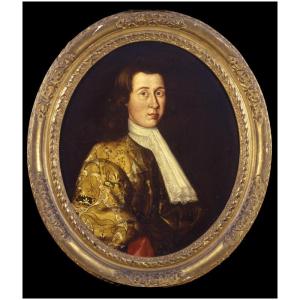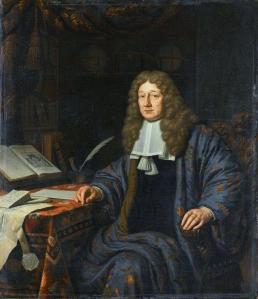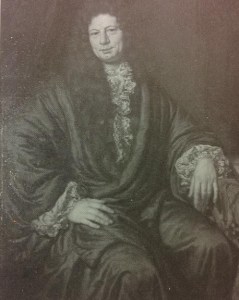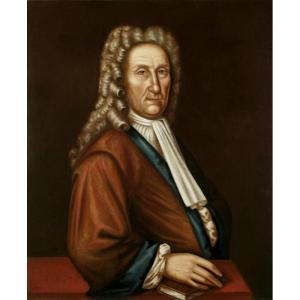
Man’s Gown. English. ca. 1700-1720. Gold silk damask (likely Chinese; ca. 1690-1720); lining: red brocaded silk (likely Persian; ca. 1700-1720); collar and cuffs: red silk damask (English; ca. 1700-1720); wool padding. Cora Ginsburg LLC.
Today’s #ColonialCouture post is by Cynthia Kok, a doctoral student in art history at Yale University. She is interested in trade and craftsmanship under European colonial governance and imitative material practices inspired by encounters with foreign cultures.
“I like my money right where I can see it…hanging in my closet.” –Carrie Bradshaw
Centuries before New York became known as a fashion capital— and Carrie Bradshaw emerged as a style icon— the city’s colonial-era merchants anticipated the words of Sex and the City’s lead character by investing newly earned wealth in clothing made from luxurious fabrics. And, like today’s Rich Kids of Instagram, they documented their exclusive material success through portraiture. Painted at the turn of the eighteenth century, that of Isaac de Peyster (1662-1728), the son of an affluent Dutch-American mercantile family, presented both his physical features and a luxurious silk robe patterned with rocks and spindly vegetation. The artist captured the soft, luminous sheen of the gold silk and hinted at the robe’s lining with a flash of red along an upturned sleeve.

Isaac de Peyster (1662-1728). Unidentified Artist. ca. 1700-1705. Oil on canvas. 74.9 x 64.1 cm. NYHS 1960.55.
Looking out from within an oval frame, de Peyster appears in the sort of loose-fitting, kimono-like robe commonly referred to as a Japonse rok in contemporary Dutch and Dutch colonial inventories. Worn by both men and women, Japonse rokken were presented to Dutch East India Company (Vereenigde Oostindische Compagnie, or VOC) officials as diplomatic gifts by the Japanese shogun in the seventeenth century.[1] Exported to the Netherlands, they quickly became prized for their comfort and beauty across Europe, where tailors soon took to making them themselves. In the Dutch-speaking world, Japonse rok eventually became a generic catchall for both genuine Japanese robes, typically made of silk and padded with silk wadding, and their Western imitations. An example of the latter is an early eighteenth-century robe made of a gold silk damask from China and lined with a red silk brocade from Persia. Padded with wool, a material rarely used in Japan, the robe was likely made in Europe, likely in the Netherlands. That each component came from a different place speaks to the extensive reach of Dutch trade as well as demand for European tailors who could make this type of fashionable garment.

Johannes Hudde. Michiel van Musscher (1645-1705). 1686. Oil on canvas. 57×49 cm. Rijksmuseum, Amsterdam, on loan from the Koninklijk Oudheidkundig Genootschap.
Its status as a luxury item made the Japonse rok a popular choice for dress seen in Dutch portraits. For example, Michiel van Musscher painted Johannes Hudde, director of the VOC, burgomaster of Amsterdam, and a respected mathematician, wearing one in 1686. Hudde gazes confidently at the viewer, surrounded by exotic objects that recall his various professional duties and skills. A carpet, likely from Kashmir or Lahore, is draped on a desk strewn with papers. A symbol of erudite sophistication in addition to wealth, cosmopolitanism, and global trade, his Japonse rok is made of an elaborately-patterned silk. Hudde’s portrait points to a growing trend for painterly depictions of genuine Asian and European silks with bright, complex, “bizarre” designs in addition to plainer silks.[2] Produced from the 1690s through the 1730s and characterized by asymmetrical and naturalistic motifs, bizarre silks were European in manufacture but inspired by Asian and Near Eastern design. Amsterdam, along with Spitalfields in England, were important centers for their design and creation .

Pierre de Peyster. Michiel van Musscher. 1683. oil on canvas. 23×20.25 in. National Society of Colonial Dames in the State of New York.
Also completed by van Musscher, a portrait of Isaac’s uncle Pierre de Peyster was sent from the Netherlands for prominent display in his brother Abraham’s Pearl Street home in 1684. Perhaps this gesture encouraged Isaac to commission his own portrait from a colonial artist who drew on conventions of Anglo-Dutch portraiture and looked to Europe for fashion cues, including the silken dressing gown.[3] He was not alone, as seen in a 1710s portrait attributed to New York artist Evert Duyckinck III depicting Colonel Geradus Beekman in a brown robe with a rich blue lining. A physician and elder of the Flatbush Reformed Dutch Church, Beekman was also the son of a VOC commissary, Wilhelmus or Willem Beeckman. Other portraits, like that of an unidentified gentleman by Evert Duyckink’s son Gerritt, feature sitters in patterned dressing gowns, possibly brocaded silk. Taken together, their robes, wigs, and the portraits themselves express their status as respectable, successful men in. Although neither was painted with as much realism as those by van Musscher, the Duyckinck portraits, like de Peyster’s, still managed to convey the sheen of silk.

Colonel Geradus Beekman, M.D. Attributed to Evert Duyckinck III (1677-ca 1725). ca. 1710. Oil on linen. New-York Historical Society.
In colonial New York, portraits of men wearing silk Japonse rokken emphasized family prestige in addition to affirming their relationships to an international trading empire centered in Amsterdam. Zara Anishanslin has noted that patterned silks like the bizarres were uncommon in colonial portraiture.[4] Unpatterned silks were much easier to paint and less likely to date a portrait as designs came in and out of vogue. De Peyster, however, opted for a pattern. In light of this, it is perhaps possible to interpret his portrait as more than a record of momentary fashion or grand display of wealth. Rather, both the portrait and the robe might be seen as a self-conscious performance of Dutch-American identity, legible as markers of power and prosperity in a former Dutch colony. They underscored continued affinity for Dutch antecedents, rather than than an abrupt, unthinking, or forced adoption of Anglo-American customs.

Portrait of a Man. Gerrit Duyckinck. c. 1690. Oil on wood panel. Private Collection.
In this way, the genre of portraiture and the donning of both patterned and unpatterned silk robes continued to connect colonial New Yorkers to trends that communicated a developing American identity whose Dutch roots ran deep. Donning the Japonse rok grounded de Peyster and his peers in a specific moment of Dutch-American history. The cut of their robes linked them to Japan and the Dutch international trading empire; their materiality and design connected them to a European textile industry and the height of European fashion; and the style of painting, visually distinct from metropolitan Dutch portraiture, placed them in colonial America. Perhaps unknowingly, Dutch-American elites were in the process of communicating an emerging American identity that linked New York to global trends, marking its inception as an international fashion capital.
[1] Asia in Amsterdam: The culture of luxury in the Golden Age, ed. Karina H. Corrigan, Jan van Campen, Femke Diercks, with Janet C. Blyberg (New Haven: Yale University Press, 2015), 195.
[2] See Peter Thornton, “The ‘Bizarre’ Silks,” The Burlington Magazine 100, no. 665 (August, 1958): 269.
[3] “Influences in Early Dutch-American Painting,”The Dutch and America, ed. Maurice Bloch and Robert L. Tusler (Los Angeles: UCLA Publication Services Department, 1982), 37; The America of 1750, Peter Kalm’s Travels, vol. 2, ed. Adolph B. Benson (New York: Wilson-Erikson Inc., 1937), 343; in Black, 121; Louisa Wood Ruby, “Dutch Art and the Hudson Valley Patroon Painters,” Going Dutch: The Dutch Presence in America, 1609-2009, ed. Joyce D. Goodfriend, Benjamin Schmidt and Annette Stott (Leiden: Brill, 2008), 46.
[4] Zara Anishanslin, Portrait of a Woman in Silk: Hidden Histories of the British Atlantic World (New Haven and London: Yale University Press, 2016), 8.
Cool Article. Though, one point…
“In the Dutch-speaking world, Japonse rok eventually became a generic catchall for both genuine Japanese robes, typically made of silk and padded with silk wadding, and their Western imitations.”
The term “Japonsch rok” is not a “catchall” for “chamber gowns” in 17th or 18th Century Dutch. It is however a word that in Dutch is used for the Japon in the 17th Century and by the turn of the century for “women’s gowns”. The term they used in the 17th Century as a catchall is Nacht rok / night dress based on 17th Century primary sources.
Again, Great article !